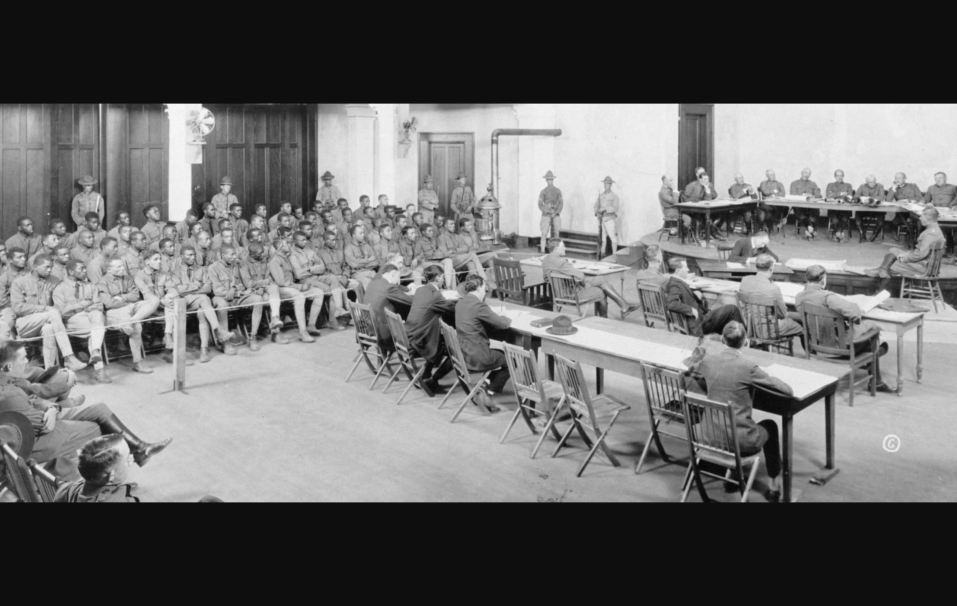By Lila Rakoczy, THC Military Sites Program Coordinator
Houston’s Memorial Park gives little indication today that it once hosted a military camp, let alone one that sparked one of the worst military mutinies in American history. And yet, the event that would become known as the Camp Logan Mutiny—or to some, the Houston Riot—would have a deep impact on how America mobilized for the First World War.
War fever gripped the nation in 1917. Houston civic leaders saw an opportunity, and successfully lobbied for the city to host a new National Guard training camp. Construction on the newly named Camp Logan began on the western outskirts of the city that summer.
To guard the site during its construction, the War Department—amidst heavy criticism—sent the 3rd battalion of the 24th Infantry Regiment. Fresh from service in Mexico during the Punitive Expedition, this African American regular army unit consisted of seasoned and experienced military veterans.
Six hundred forty-five men from companies I, K, L, and M took up temporary residence less than a mile from Camp Logan. From the beginning, relations between the men of the 24th Infantry and white Houstonians were tense. In response, the military limited access into the city and instead encouraged local African Americans to venture into the camp.
The soldiers resented the racial slurs directed at them by white workmen at the camp’s construction site, as well as the racial segregation signs and restrictions they encountered in the camp and throughout the city. In an effort to placate the local white population, soldiers who ventured into the city—even military police—were denied the right to carry weapons.
August 23, 1917
The men of the 24th endured nearly a month of petty slights and humiliations in the Jim Crow city. Matters came to a head on a Thursday morning when two Houston police officers disturbed a dice game and burst into a private citizen’s home to search for the suspects. When the African American resident objected, one of the police officers racially abused her and dragged her into the street in her undergarments.
A nearby army private from Company L, Alonzo Edwards, tried to peacefully intervene and was pistol whipped and arrested. Later, an African American military policeman inquired after Edwards and was similarly beaten and arrested. By evening, rumors—erroneous, as it happens—reached the camp that Cpl. Charles Baltimore had been killed by the police.
Pandemonium followed. Most of the garrison followed orders to stay and, fearing the worst, prepared for a possible attack. Perhaps as many as a quarter of them grabbed arms and headed into the city. In the violence that ensued, several Houstonians were wounded and 17 killed. Among the dead were five police officers. As light broke, Gov. James Ferguson declared martial law in the city.
Court Martial and Sentence
To prevent retaliatory lynchings, the military removed the 24th Infantry from Houston and blocked the city’s attempts to assert legal jurisdiction, much to the outrage of city officials. The general confusion over which men had actually participated did not deter the government from charging 63 men that November, in what would eventually be the first of three court martials in San Antonio. Proceedings lasted for 22 days and involved nearly 200 witnesses. All the men pleaded not guilty and shared just one lawyer among them. A small number were granted immunity in exchange for pointing the finger at comrades.
On November 29, a verdict was returned: Forty-one men were sentenced to hard labor, four to shorter prison sentences, and five acquitted. Thirteen were sentenced to death. The condemned men were not told their fate until two days before their execution, nor was time permitted to appeal for clemency. Instead, the execution was hastily carried out before dawn at a secluded edge of Camp Travis along Salado Creek. Their request to be shot had been denied. The gallows upon which they were hanged were gone by the time the news broke to the public.
Aftermath
The fallout of the events in Houston and San Antonio had far-reaching consequences. Public opinion in white America pushed the Wilson administration to keep the four Regular Army units—the 24th and 25th Infantry Regiments, and the 9th and 10th Cavalry Regiments—far from France. In their place were sent African American men from National Guard units, most of them in the North, and an even larger force of drafted civilians from across the U.S. Beyond the war itself, the treatment of the 24th Infantry galvanized black America to push for changes in how military law was administered, with repercussions still felt today.

